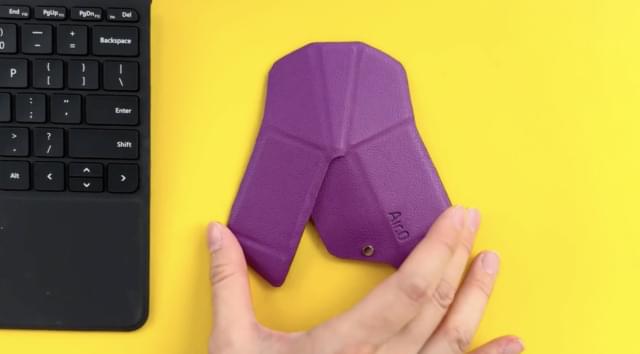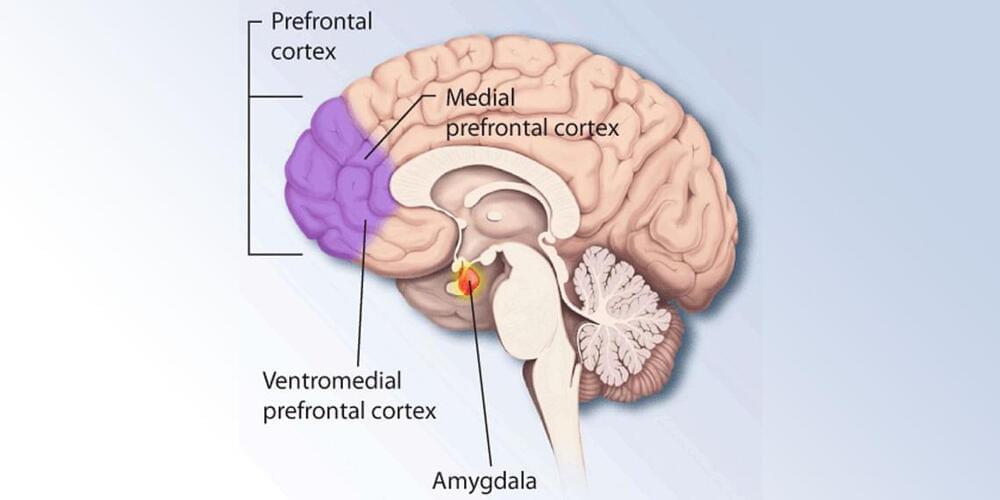We’re cautiously optimistic about our new findings.



If it’s been a while since you’ve tackled the art of origami, don’t worry—you don’t need any crafty folding skills to prep the Air.o for use. Squeezing the sides of the flattened Air.o pushes it into its mouse formation, while a small but mighty magnet holds everything together. Dissembling the Air.o is said to be as easy as undoing the magnet and pushing down on the mouse to turn it into a geometric pancake. According to Air.o, the mouse’s vegan leather (AKA plastic) skin will retain its integrity even after being manipulated again and again. It’ll even survive nasty falls onto hard surfaces if Air.o’s Kickstarter page is anything to go off of.
For those who enjoy the “digital nomad” lifestyle but hate using a trackpad, the Air.o could be a game-changer. There are plenty of lightweight Bluetooth computer mice on the market these days, but none of them flatten into something that could pass as a bookmark in a pinch. Air.o’s Kickstarter page says the team elected to make a full-size mouse to avoid the fatigue that comes with using a mini mouse—a tiny (and frankly irritating to use) device that often ends up being added to people’s go bags for lack of better options.
As with any other Kickstarter campaign, there’s no saying whether the Air.o will ever make it to adopters’ bags and pockets (though this campaign in particular has surpassed its fundraising goal by a long shot, so there’s hope). It’s also difficult to say exactly how easy the Air.o is to use for long periods of time; the mouse’s design, though clever, might be uncomfortable for some. At only $49 USD per mouse, however, the Air.o does appear to be worth trying, if only to impress the people sitting near you at a cafe or on your next flight.

𝐍𝐢𝐜𝐨𝐭𝐢𝐧𝐞 𝐁𝐥𝐨𝐜𝐤𝐬 𝐄𝐬𝐭𝐫𝐨𝐠𝐞𝐧 𝐏𝐫𝐨𝐝𝐮𝐜𝐭𝐢𝐨𝐧 𝐢𝐧 𝐖𝐨𝐦𝐞𝐧’𝐬 𝐁𝐫𝐚𝐢𝐧𝐬
𝙏𝙝𝙚 𝙥𝙧𝙤𝙙𝙪𝙘𝙩𝙞𝙤𝙣 𝙤𝙛 𝙚𝙨𝙩𝙧𝙤𝙜𝙚𝙣 𝙞𝙣 𝙩𝙝𝙚 𝙩𝙝𝙖𝙡𝙖𝙢𝙪𝙨 𝙖𝙥𝙥𝙚𝙖𝙧𝙨 𝙩𝙤 𝙗𝙚 𝙘𝙪𝙧𝙩𝙖𝙞𝙡𝙚𝙙 𝙗𝙮 𝙟𝙪𝙨𝙩 𝙤𝙣𝙚 𝙙𝙤𝙨𝙚 𝙤𝙛 𝙣𝙞𝙘𝙤𝙩𝙞𝙣𝙚, 𝙚𝙦𝙪𝙞𝙫𝙖𝙡𝙚𝙣𝙩 𝙩𝙤 𝙩𝙝𝙖𝙩 𝙞𝙣 𝙖 𝙘𝙞𝙜𝙖𝙧𝙚𝙩𝙩𝙚, 𝙧𝙚𝙫𝙚𝙖𝙡𝙨 𝙖 𝙬𝙝𝙤𝙡𝙚 𝙗𝙧𝙖𝙞𝙣 𝙖𝙣𝙖𝙡𝙮𝙨𝙞𝙨 𝙤𝙛 𝙝𝙚𝙖𝙡𝙩𝙝𝙮 𝙬𝙤𝙢𝙚𝙣 𝙞𝙣 𝙩𝙝𝙚 𝙛𝙞𝙧𝙨𝙩 𝙨𝙩𝙪𝙙𝙮 𝙤𝙛 𝙞𝙩𝙨 𝙠𝙞𝙣𝙙.
“We were surprised to see that this effect could be seen even with a single dose of nicotine, equivalent to just one cigarette, showing how powerful the effects of smoking are on a woman ’ s brain.”
Emphasizing the preliminary nature of the study and the need for a larger sample, she added: We’re still not sure what the behavioral or cognitive outcomes are; only that nicotine acts on this area of the brain.
However, we note that the affected brain system is a target for addictive drugs, such as nicotine.

Watch The Kardashev Scale Type 1: What Would Be Our CIvilization?
https://youtu.be/zHFN8VrLBdc.
–
A type 1 civilization on the Kardashev scale manages to take advantage of 100% of the energy produced by its planet, control the climate, move continents and even change its planet’s rotation. In this sense, how long does the human race lack to become a type 1 civilization? Are we close to achieving it, or are we still far away?
Ready, let’s start! “Introduction“
The level of technological development of any civilization can be measured mainly by the amount of energy they need. But, it also encompasses the management of that energy and how they use it to develop and grow on their home planet.
Following Kardashev’s definition, a Type I civilization is capable of storing and using all the energy available on its planet; this includes all known electricity generation methods, as well as those that depend on the elements available on the planet, nuclear fusion and fission, geothermal energy, as well as that which they can collect from their star without leaving the planet.
The human race has not yet reached this level of development, but will we ever reach it? And if so, when will we achieve it?
Previously we already made a series of 3 videos in which we address the three types of civilizations that exist according to the Kardashev scale. “Enter here images of the series on the scale of Kardashev.“
But today, we will focus on analyzing why the human race has not yet managed to become a type 1 civilization and how far we need to become one.
The Great Filter.
-
“If You happen to see any content that is yours, and we didn’t give credit in the right manner please let us know at [email protected] and we will correct it immediately”
“Some of our visual content is under an Attribution-ShareAlike license. (https://creativecommons.org/licenses/) in its different versions such as 1.0, 2.0, 30, and 4.0 – permitting commercial sharing with attribution given in each picture accordingly in the video.”
Credits: Ron Miller, Mark A. Garlick / MarkGarlick.com.
Credits: NASA/Shutterstock/Storyblocks/Elon Musk/SpaceX/ESA/ESO/ Flickr.
00:00 Intro.

Scientists from the U.S. Department of Energy’s National Renewable Energy Laboratory (NREL) and Lawrence Berkeley National Laboratory (Berkeley Lab) are providing researchers with a guide to how to best measure the efficiency of producing hydrogen directly from solar power.
Photoelectrochemical (PEC) water-splitting, which relies on sunlight to split water into its component elements—oxygen and hydrogen—stands out as potentially one of the most sustainable routes to clean energy. Measurements of how efficient the PEC process is on an identical system can vary wildly from different laboratories, however, from a lack of standardized methods. The newly developed best-practices guide published in Frontiers in Energy Research is intended to provide confidence in comparing results obtained at different sites and by different groups.
The publication provides a road map for the PEC community as researchers continue to refine the technology. These best practices were verified by both laboratories via round-robin testing using the same testing hardware, PEC photoelectrodes, and measurement procedures. Research into photovoltaics has allowed a certification of cell efficiencies, but PEC water-splitting efficiency measurements do not yet have a widely accepted protocol.

A study on a large sample of patients found chronic, long-lasting depression to be associated with reduced brain volume. The reduced volume was found in brain regions relevant for planning one’s behavior, focusing attention, thinking, learning and remembering and also in regions relevant for regulating emotions. The study was published in Neurobiology and Treatment of Depression.
Depression, also called major depressive disorder, is a mood disorder that causes a persistent feeling of sadness and loss of interest. It changes the way a person feels, thinks and behaves. For many people suffering from it, depressive episodes become a recurring event. More than half of patients with depression experience a relapse after 2 years and the probability of recurrent depressive episodes rises to 90% after 3–4 episodes. Studies have indicated that recurring depressive episodes might be linked to structural changes in the brain, but the existing results are not uniform.
Ms. Hannah Lemke and her colleagues analyzed the data of 681 patients from the Marburg-Muenster-Affective-Cohort Study (MACS) in order to better link properties of the course of depressive disorder with specific changes in the brain structure. Patient data were collected at two sites in Germany – Muenster and Marburg.

Weill Cornell Medicine researchers have developed a computational method to map the architecture of human tissues in unprecedented detail. Their approach promises to accelerate studies on organ-scale cellular interactions and could enable powerful new diagnostic strategies for a wide range of diseases.
The method, published Oct. 31 in Nature Methods, grew out of the scientists’ frustration with the gap between classical microscopy and modern single-cell molecular analysis. “Looking at tissues under the microscope, you see a bunch of cells that are grouped together spatially—you see that organization in images almost immediately,” said lead author Junbum Kim, a graduate student in physiology and biophysics at Weill Cornell Medicine.
“Now, cell biologists have gained the ability to examine individual cells in tremendous detail, down to which genes each cell is expressing, so they’re focused on the cells instead of focusing on the tissue structure,” he said.

On the other, because organisms share the same universal code, they’re vulnerable to outside attacks from viruses and other pathogens—and can transfer their new capabilities to natural organisms, even if it kills them.
Why not build a genetic firewall?
A recent study in Science did just that. The team partially reworked the existing genetic code into a “cipher” that normal organisms can’t comprehend. Similarly, the engineered bacteria lost its ability to read the natural genetic code. The tweaks formed a powerful language barrier between the engineered bacteria and natural organisms, isolating each from sharing genetic information with the other.
Is a science fiction short story and subsequent novel written by Daniel Keyes.